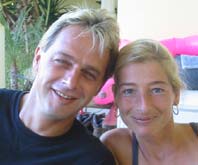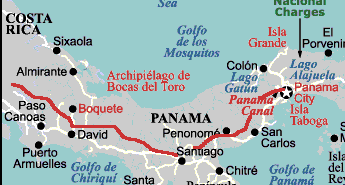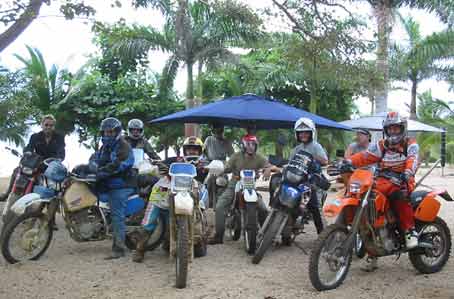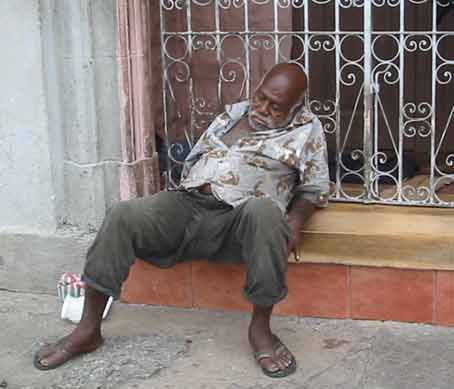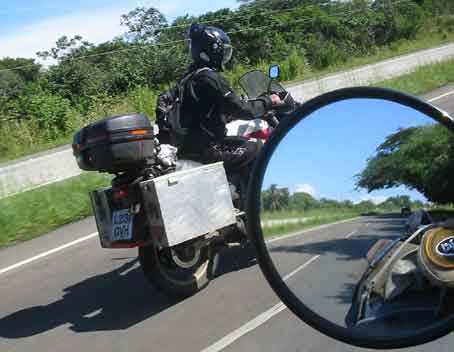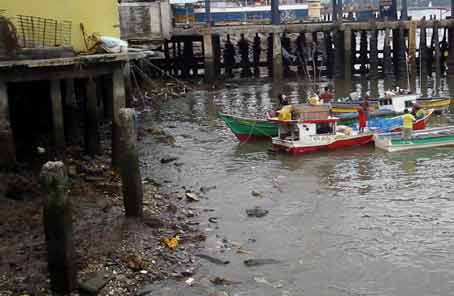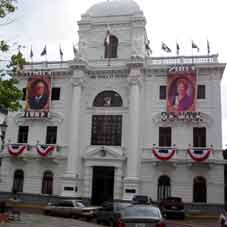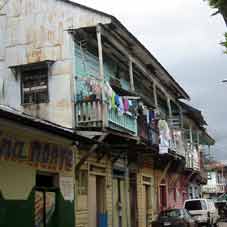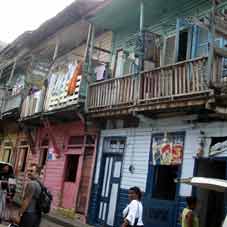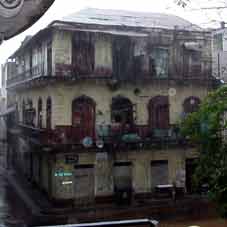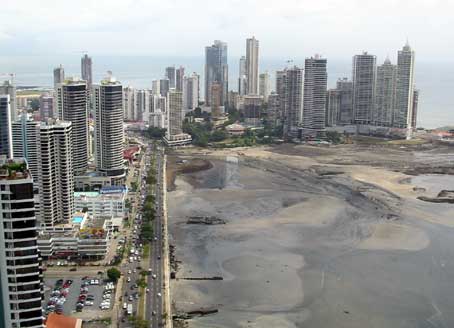Friday,
21 November 2003.
Thank you to all of you for letting me know the result of the rugby and I did
notice that the English were the first to email me, I wonder why?
I had made a big bowl of rice pudding the night before for everyone as it was
our last day in Nicaragua. Albert, one of the Musketeers, had decided that the
excitement was too much for him and he decided to stay a bit longer on the beach.
He also had to return home, in Austria, two weeks later to work. Catherine was
staying a little longer as well, obviously enjoying Albert attention, before
visiting friends in Costa Rica.
So I left, with the Bearded Monkey (Steffen) on his KTM, in the middle of the
morning. We reach the border an hour or so later and spent the next three and
half hour running around from one office to the other. First we had to pay US$3
to leave Nicaragua then US$15 to enter Costa Rica. By 2.30pm we were on our
way to Tamarindo some 150km farther south.
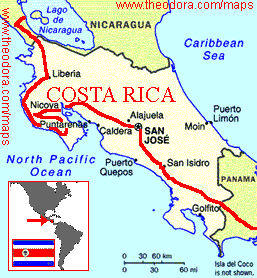
Costa
Rica is famous for its enlightened approach to conservation. About 27% of
the country is protected in one form or another, and more than 13% is within
the national park system. It is very popular with the Americans; they come to
see monkeys, sloths, caymans, sea turtles and exotic birds in their natural
habitat. Costa Rica has had democratic elections since the 19th century and
is now one of the most peaceful nations in the world. Armed forces were abolished
after the 1948 civil war, and Costa Rica has avoided the despotic dictatorships,
frequent military coups, terrorism and internal strife that have torn other
countries
in
the region. It is also one of the safest in the region but also one of the most
expensive.
We could have hike through rain forest, peer into the smoking craters of active
volcanoes, snorkel on tropical reefs and surf the best waves in Central America
instead we decided to join a group of local bikers for a ride along the Pacific
Ocean.
We
arrived at Jogi and Verena Gerner's house late in the afternoon.
This young and dynamic couple from Germany has been living in Tamarindo
for 10 years. They have a daughter, Laura, and a real estate business. Among
other things, Jogi is an avid off road rider and he had organised a ride with
some friends for that week end.
We all met at 8am on a sunny Saturday morning. Seven others riders turned up,
among them there were
two
Italian motocross specialist. The ride was 90 km long, all of it on unsealed
roads.
We crossed many rivers (photo) and even rode
over a suspended bridge as the river was too high to ride through. We stopped
for breakfast and lunch in basic country restaurants. We really had fun even
though it was hard work for Steffen and I, our bikes are just a little too big
and heavy for that kind of riding. For the others it was like a walk in the
park but they always waited for us. We arrived at Playa Samara late in
the afternoon and I shared a bungalow, right on the beach,
with three other riders. I was told that this beautiful,
gentle, white-sand beach is one of Costa Rica's
safest and prettiest. Straight away the boys got into some serious drinking
(I am the boring one, I drink soft drinks) as we watched the sunset from our
bungalow.
There were a few sore heads the next morning but we got together for breakfast
at 9am and rode back to Tamarindo on the paved road.
Thank you to all of you for that off road riding lesson. Thank you also to Jogi
and Verena for having us in their beautiful house.
Monday, 27 November.
We left early that morning in the direction of San Jose, the capital.
We reached it around midday after having been stopped by the police once for
speeding but I was able to persuade him to let us go without a fine. Having
no business in the capital we went quickly through it, actually not that quick,
I lost my way somehow. When I finally got us out it started to rain heavily,
we got soaked in no time. Steffen wanted to turn around and go
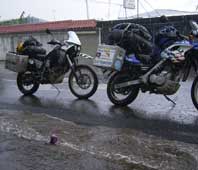
back to San Jose but I eventually convince him
to keep going. When I ride by myself I only stop for petrol and a quick drink
here and there but with the Bearded Monkey we have to stop all the time. Smoking
is the most common one but he also has to stop to have a piss, blow his nose
or scratch his arse. I could also mention the whinging but if I do that will
give him another reason to whinge. One hundred km later we reached the Interamericana
highway highest point near the mist-
shrouded
3491m peak of Cerro de la Muerte. This ride would have been perfect on a sunny
day but that day, with the rain, the mist and the cold, it was not pleasant
at all. From there, the road dropped steeply to the town of San Isidro de
General. San Isidro is the main town in southern Costa Rica and we had decided
to spend the night there. The cheapest place to stay that we could find cost
us US$3 each but then we had to pay another US$2 to park our bikes in a safe
place. It was very tiny which made it hard for us to dry our clothes. Every
single thing in my bag was soaking wet.
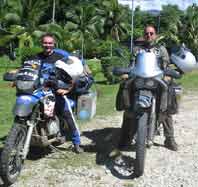
The
next morning was sunny again and we were on the road at 7am, keen to make it
to the border of Panama before lunch. The road went through mainly agricultural
lowlands and had a real tropical feel about it. This is the best time of the
year to visit this region because it is just at the end of the raining season
and everything is still lushly green. In Central America and in most of South
America there are only two seasons, the dry season which is summer and the wet
one which is winter. Temperature stays mostly the same all year long but sometime
the summer days are cooler than in winter.
We
arrived at the border at 10am and were back on the road at 12.30. It turned
up to be a very easy border crossing. No photo copies or trips from one office
to another one were necessary and the good news was that I had to pay only US$6
altogether.
Panama is mostly known for its canal and the 1989 US invasion to depose General
Manuel Noriega but as I remember from a previous visit it does offer some of
the finest natural scenery and ecotourism possibilities in Central America as
well.
Panama
is an 800km land bridge where the wildlife of North and South America meet and
intermingle. Because of this geographical position, Panama is home to more than
940 bird species. Few countries offer such dramatic contrasts in such a small
area: lush tropical rain forests in the central and eastern regions.
cool,
fresh volcanic mountains to the west: relaxing Caribbean and Pacific islands.
It has a population of around 3 million people which again make an interesting
combination of Spanish, Latin American, Caribbean and indigenous cultural influences
with immigrants from Asia, Europe, the Middle East and other places that spice
up the mix.
A couple of weeks ago they celebrated their 100 years of independence from Colombia
which took part in November 1903.
Having another 500km to travel to Panama City we decided that we would
stop in Santiago for the night. The road was very good but again we got
the afternoon rain, so much for the end of the raining season. We got soaked
again but when we finally arrived in Santiago
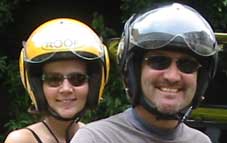
we
meet up with two other bikers. Simon Kennedy, from England, is riding
a Honda Transalp and his girlfriend Rachel, from France, is riding a
Kawasaki KLR250. Since leaving Europe they have been to Asia, Australia and
America. They started with only one bike but Rachel got her license in Australia
and bought her 250. She is now an elegant, petite and sometime tough motorcycle
rider. Simon (Mad Max
Simon
I call him), on the other hand, is more like a suave and debonair rider but
a Pom all the same. Anyway, they were both pissed off from the rain and had
decided to spend the night here as well.
We all got together the next morning for le petit dejeuner and decided to ride
jointly to Panama City which was only 260km away. The sun had reappeared and
the Bearded Monkey was not whinging (how could he? We had a Pom with us). Having
a lady with us meant that we had to make more frequent toilet stops and that
seemed to please the B M.
We arrived in Panama City early in the afternoon. The capital is a modern,
thriving centre for international banking, business, trade and transportation,
with a cosmopolitan flair. The cheapest hotels are in the colonial part of the
city which is called Casco Antiguo. This area is very interesting but
it can be dangerous, especially at night. We were also told not to walk
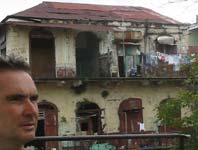
down
the side streets during the day. Sadly, nowadays many of the buildings are dilapidated
but they have started to restore some of them. Currents plans are to move the
poorer residents to other areas of the city. Nevertheless I managed to convince
my compañeros to stay in that area. I found a very basic and cheap hotel
with a safe parking. After a couple of days they approved of my choice and they
said that it was much more interesting and less boring than the modern city.
Panama was the end of the road for us because
the Interamericana Hwy stops just 100km from here and reappears 150km farther
on, far beyond the Colombian border. This break in the highway between Central
America and South America is known as the Darién Gap, where
untamed jungles are a major obstacle to travel and it is unlikely that any
road will be built to complete the missing link. Although a trickle of travellers,
including myself, have walked through this swamp, the presence of Colombian
guerrillas, paramilitary, smugglers, bandits and plain old thieves pretending
to be guerrillas make this a foolishly dangerous trip. I did it in 1992 and
to this day it remains one of my most dangerous and physical experience and
to be honest I don't think that I would do it again. Click
here to find out more about that trip. With that in mind, the only thing
to do for us was to send our motorbikes by air and with my latest Mongolian
incident still fresh on my mind I was going to make sure that nothing was
going to go wrong this time. While I went to the airport to visit the Girag
cargo company to find out about cost, schedule and condition, the others inquired
about shipping the bikes by sea. When we met again that night we all agreed
that shipping by air was the cheapest and best option. It was going to cost
us US$330 each and I had it scheduled for the following Tuesday. The next
day, Friday, we booked our flight to Bogotá for the following Wednesday.
That cost us an extra US$189, which we agreed that it was a bargain. Rachel
had decided not to go to Colombia; instead she will ship her bike by sea to
Chile. In the meantime we were going to explore the place, starting with the
canal.
Sunday, 30 November.
The best and closest place to see it was Miraflores, only 15 km from
down town Panama. I went there with my good friend Steffen (he had promised
me that he would not whinge).
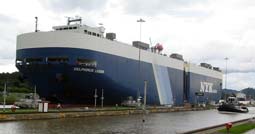
The
canal is one of the world's most significant waterways, truly an engineering
marvel, stretching 80km from Panama City on the Pacific side to Colon on the
Atlantic side, cutting right through the Continental Divide. Nearly 14,000 ships
pass through the canal each year. Ships worldwide are built with the dimensions
of the Panama Canal's locks in mind: 305m long and 33.5m wide.
As you can imagine it was not built in a week.
The idea of a canal across the isthmus was first broached in 1524, when King
Charles V of Spain ordered a survey to determine the feasibility of constructing
such a waterway. In 1878, the Colombian government awarded a contract to build
a canal to the French. Ferdinand de Lesseps, who had built successfully
the Suez Canal, got the contract. He began the work in 1881 and was
determined to build a sea-level canal but the project proved more difficult
than anyone had expected. Yellow fever and malaria killed 22,000 workers
and finally insurmountable construction problems and financial mismanagement
drove the company bankrupt by 1889. Eventually, the French, unable to complete
the canal, agreed to sell the concession to the Americans. Construction began
again in 1904 and took 10 years and more than 75,000 workers and cost almost
US$400 million. Like the French, the new builders faced unprecedented problems:
tropical diseases; constant landslides; the complexity of the massive volume
of excavation needed; the enormous size of the locks; and the need to establish
new communities, import materials, and organize work on an unprecedented scale.
The first ship sailed through the canal on August 15, 1914. The Americans
controlled the canal until December 31, 1999. Now it is fully controlled and
owned by Panama.
Ships used to pay according to their weight but now they are charged according
to their type and size. An average fee is around US$110,000. The highest amount
paid was US$190,000 by an US registered container ship and the lowest was
US$0,36, paid in 1928 by Richard Halliburton, who swam through in 10 days.
All in all it was quite an interesting visit except that we got drenched again
while riding back to Panama and of course we got lost. That was enough to
get the Bearded Monkey to whinge again.
Tuesday, 2 December.
We took the bikes to the airport quite early. We were asked to empty the petrol
tanks but as I could not be arsed I just pretended to do it using a fake hose
and some left over petrol from the others. We left the airport with the promise
that our bikes would be delivered the next day in Bogotá.
With the dissolution of the three Musketeers I had to think of a new name
for new group facing big adventures in Colombia and it came quite easily,
just by observing the other two. "The good, the bad and the ugly"
is the new name but I will not tell you which one is which only that I am
the first one.
Today is our last day in Panama and I am very happy about it because by now
I just cannot stand it any longer. OK, at first, it was quite interesting
but that did not last. I was sick of the rain, the trash in the streets and
the unfriendly people. But what broke the camel back was the mice in my room.
I don't mind spiders, snakes or cockroaches but I cannot stand mice or rats.
One night they ate a piece of bread that was centimetres from my face. Just
the sound of them going through our plastic bags keeps me awake and horrified.
So this morning, right after breakfast, we took a local bus to the airport
which took just about an hour and we arrived just 30 minutes before take off.
Going through the check out took more time and by the time we went through
we only had 15 minutes left. The good and the bad got through all right but
the Ugly, travelling with an Irish passport, was told that he needed a visa
for Colombia and he did not have one (I did not dare tell him an Irish joke
just then). He had to go back to Panama City, find the Colombian Embassy and
hopefully fly to Colombia the next day. I will let you know what happen to
him in my next update. It was time to say good-bye to Rachel and with
only minutes to spare we ran quickly and just made it in the plane as they
were closing the door. The plane took off and we said farewell to Central
America.
Colombia is one of the most dangerous
countries on earth. With kidnappings, car bombings, hold-ups and murders happening
every day the Good, the Bad and the Ugly should have plenty of adventures.
I hope I can write about them soon and if you don't hear from me in the next
three weeks or so, please come and save me!!!!!!!!!!
Click here to see more photos.
JOURNAL 29.
03/12/03 . Costa Rica . Panama . Kilométrages
jusqu'à maintenant 55,050km.
Vendredi
21 Novembre 2003.
Pour ma dernière journée au Nicaragua j'avais fait un grand bol
de riz au lait pour tous mes compagnons. Albert, un des mousquetaires,
avait décidé que les événements des deux dernières
semaines l'avaient fatigué énormément et qu'il préférait
rester quelques jours de plus sur la plage. En plus, le travaille l'attendait
en Autriche début décembre, les vacances étaient finis
pour lui. Catherine, quand à elle, avait envie de se faire dorée
au soleil deux ou trois jours de plus.
J'ai donc repris la route avec Steffen (l'Allemand avec la KTM) par un
beau matin ensoleillé vers la frontière du Costa Rica qui ce trouvait
seulement à une cinquantaine de km. Nous y passions trois heures et demie
à aller d'un bureau à l'autre. D'abord nous avons payé
3 Euros pour sortir du Nicaragua et ensuite 15 Euros pour entrer au Costa Rica.
Il était 14h.30 quand nous reprenions finalement la route vers Tamarindo,
un village sur la côte Pacifique à 150 Km au sud de la frontière.

Le
Costa Rica est reconnu pour la protection de sa nature. Environ 27% du
pays sont des parques nationales. C'est aussi un pays qui est très populaires
avec les Américains, ils y viennent pour voir des singes, des caïmans,
des tortues de mer et des oiseaux exotiques. Il faut dire aussi que les Américains
n'ont plus beaucoup de choix dans leurs destinations vacancières car
depuis les événements de ces dernières années beaucoup
de pays ne les accueillent plus à bras ouvert. Le Costa Rica a des élections
démocratiques depuis le dix-neuvième siècle et il est maintenant
un des plus tranquille pays du monde. Il n'y a plus d'armées depuis la
guerre civile de 1948 et le Costa Rica a pu éviter les coups d'état,
les gouvernements dictateurs et le terrorisme
qui
sont très fréquents dans d'autres pays de la région. On
peut le visiter en toute sécurité et tranquillité sans
problème. Malheureusement pour moi, c'est aussi le plus cher pays d'Amérique
Centrale.
A Tamarindo, nous étions accueillis par Jogi et Verena
Gerner (des amis de Steffen). Ce jeune couple Allemand ont une fille de
11 ans (Laura) et habitent au Costa Rica depuis une dizaine d'années.
Jogi est aussi un passionné d'enduro et il avait organisé, pour
ce week end là, une balade tout terrain en moto. On en profitait pour
les accompagner. Le départ était prévu pour 8 heures du
matin et 9 motards étaient au rendez-vous. Parmi eux, il y avait deux
Italiens spécialistes en MotoCross, de quoi intimidé un spécialiste
des routes goudronnées comme moi. Le parcourt
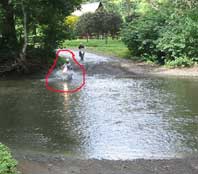
suivait
la côte mais que sur des chemins de terre, nous traversions nombreuses
rivières (photo) et je dois dire que mes compagnons, tous sur des motos
de cross, nous en mettaient plein la vue mais ils nous attendaient toujours.
Steffen, avec sa KTM, avait les mêmes problèmes que moi. Nos motos
étaient trop grosses et trop lourdes pour ce genre de circuit. En Début
d'après midi, une rivière était trop profonde pour être
traverser en moto et nous devions la traverser sur un pond suspendu qui était
prévu pour des piétons. Nous arrivions à Playa Samara
tard dans l'après midi et je partageais un bungalow, qui se
trouvait sur la plage, avec trois autres motards.
On me disait que cette belle, tranquille plage au sable blanc était
l'une des plus belles plages de Costa Rica et je veux bien le croire. Mes
compagnons passaient aux choses sérieuses et s'installaient au bar
tout en observant le couché du soleil.
Le lendemain matin, il y avait de la migraine dans l'air pour certains motards
mais nous nous rassemblions quand même pour prendre le petit déjeuner
et reprenaient peu après la route du retour mais cette fois sur une
route goudronnée.
Merci à tous pour cette leçon de MotoCross et merci aussi à
Jogi et Verena pour leurs hospitalités.
Lundi 27 novembre.
Nous partions tôt ce matin là en direction de San José,
la capitale de Costa Rica. La route était belle et le paysage très
verdoyant aussi. On se faisait arrêter une fois par la police pour excès
de vitesse mais j'arrivais à lui faire comprendre qu'il aurait plus
facile à faire sortir du sang d'un caillou que des dollars de moi.
Steffen n'en revenait pas car tout Allemand qu'il est, il avait déjà
sorti son porte feuille. Nous reprenions la route gaiement mais gentiment.
On arrivait à San José vers midi et comme on avait rien à
y faire, sinon de la traverser, on continuait de plus belle. Malheureusement
la chance n'était plus avec nous et après mettre un peu perdu
en essayant de trouver mon chemin, la

pluie faisait son apparition. Je ne sais pas si vous connaissez la pluie tropicale
mais je peux vous dire que quand ça tombe ça ne fait pas sans
blanc. Mon collègue Allemand, habituait aux petites plus fines des forêts
Bavaroises, voulait faire demi tour et trouver un hôtel pour s'y réfugier.
Cela était hors de question pour moi car il n'était que 13 heures.
J'ai éventuellement réussi à le convaincre de continuer.
Quand je roule tout seul, je ne m'arrête que pour mettre de l'essence
ou pour me désaltérer mais avec Steffen, il faut s'arrêter
tout le temps. Si ce n'est pas pour fumer
fumer
une cigarette c'est pour faire pipi ou bien se moucher ou encore se gratter
l'oignon. C'est l'enfer. On reprenait la route sous la pluie et 100 Km plus
loin je passais le plus haut col de Costa Rica (3491m). Pas besoin de vous dire
qu'il ne faisait pas chaud du tout, nos habits trempés n'amélioraient
rien. La route mouillé et sinueuse, la visibilité, rendu nulle
par le brouillard, nous faisait rouler doucement. Ensuite la route est redescendue
abruptement jusqu'à San Isidro de Général, une petite
ville qui me paraissait idéal pour passer la nuit. J'étais fier
de moi de trouver un hôtel à 3 Euros, chose très rare au
Costa Rica, mais ma fierté disparaissait rapidement car on devait payer
2 Euros chacun en plus pour garer les motos dans un garage. La chambre était
minuscule se qui rendait notre mission de faire sécher nos affaires impossible.
Toutes mes affaires étaient trempées et je n'avais rien de sec
pour me changer. Il ne me restait plus qu'à me coucher en écoutant
Steffen se plaindre.
Le lendemain, le soleil avait réapparu et nous étions résolus
d'atteindre la frontière du Panama avant

midi.
La route passa à travers une région très tropicale avec
palmiers, cocotiers et bananiers, le tout enveloppés d'une brume matinale.
C'est la meilleure période de l'année pour visiter cette région
car c'est la fin de la période des pluies et tout est verdoyant. En Amérique
Centrale et dans presque toute l'Amérique du Sud il n'y a seulement que
deux saisons. La saison des pluies qui est l'hiver et la saison sèche
qui est l'été. Les températures restent à peu prés
pareilles toutes l'années mais, des fois, il fait plus frais en été.
Aucun problème pour passer la frontière, nous y étions
à 10h et reprenions la route à midi et demi. Ils ne nous demandaient
aucune
photo
copie et on payait seulement 6 Euros chacun. Le Panama est surtout connu
pour son canal et pour l'invasion des Américains en 1989, pour éliminer
le général Manuel Noriega mais le Panama offre aussi des paysages
tropicaux de tout genre et plus de 940 différentes sortes d'oiseaux.
Le
Panama
est une sorte de pont de 800 Km qui joint l'Amérique du Nord et l'Amérique
du Sud. Seul quelques pays offrent de tels contrastes dans une si petite région:
des forêts tropicales, des montagnes volcaniques rafraîchissantes,
des plages au sable blanc au bord de la mer Caraïbe sans oublié
les îles du Pacifique. La population est d'environ 3 millions d'habitants.
Celle-ci est très variée aussi. Africains, Asiatiques,
et
indigènes en font un pays très colorés. Le Panama avait
célébré ses cent ans d'indépendance de la Colombie
deux semaines avant notre arrivés.
Comme nous étions encore à 500 Km de Panama City nous décidions
de faire halte pour la nuit à Santiago, une petite ville à
240 Km de la frontière. J'étais content car toutes mes affaires
étaient finalement séchées mais je me souciais quand même
car je pouvais apercevoir à l'horizon des nuages plutôt menaçant.
Mon inquiétude ne fut pas en vain car à moins de 100 Km de notre
destination finale un orage tropical nous tombait dessus. Encore une fois nous
étions trempés comme des lavettes. A Santiago, nous sommes tombés
sur deux autres motards que nous avions rencontrés brièvement
au

Nicaragua.
Simon Kenndy, un Anglais pilotant une Honda 650 Transalp et sa copine
Rachel Delavaud, une Française au guidon d'une Kawasaki KLM 250.
Ils avaient visité l'Asie, l'Australie, les Etats-Unis et l'Amérique
Centrale et comme moi descendaient jusqu'en Argentine. Ils avaient commencé
avec une seule moto mais Rachel avait passé son permis moto en Australie
et avait acheté sa 250cc. Maintenant, c'est une élégante
et gracieuse motarde. Simon, quand à lui, est plutôt du
genre
suave et débonnaire. Toujours est il qu'ils étaient trempés
autant que nous et avaient décidé de passer la nuit à Santiago.
Nous repartions tous ensemble, après le petit déjeuner, pour Panama
city. Comme nous avions une Dame avec nous, les arrêts toilettes, vous
l'avez deviné, étaient beaucoup plus fréquent.
Nous arrivions à Panama City dans la mi-journée. La capitale est
une ville moderne mais les hôtels pas chers sont dans la vieille ville
coloniale qui s'appelle Casco Antiguo. C'est un coin très intéressant
mais aussi très dangereux, surtout la nuit. On nous disait même
d'éviter de marcher dans les petites rues en plein jour.

Malheureusement,
cette ville coloniale est en train de tomber en ruine. Ils ont quand même
commencé à restaurer quelques bâtiments et ont entrepris
de déplacer les résidents les plus pauvres et de les mettre dans
d'autres quartiers. J'ai quand même réussi à convaincre
mes compañeros de rester dans ce quartier et je leur trouvais un hôtel
très primitif mais avec un parking de haute sécurité pour
les motos. Après un petit tour dans les environs ils étaient tous
d'accord avec moi que ce coin était vraiment captivant et bien moins
ennuyant
que
la ville moderne.
Pour nous, le Panama était un cul de sac car il n'y a pas de route que
connecte le Panama avec la Colombie. En effet, il n'y a pas de route qui relie
l'Amérique Centrale avec l'Amérique du Sud. Celle-ci s'arrête
au Panama et reprend 150 Km plus loin, bien après la frontière
Colombienne. Cette région s'appelle le Darien Gap. Il n'est pas
possible de construire une route à travers le Darien Gap car cette région,
couverte de forêts tropicales, est comme un gigantesque marécage.
Bien que quelques intrépides voyageurs aient traversé ce marécage
à pied, la présence de guérillas Colombiennes, paramilitaires,
contrebandiers, bandits et voleurs en font une aventure très dangereuse.
Je l'ai fait en 1992 et reste jusqu'à aujourd'hui une de mes plus dangereuse
et physique expérience et je dois dire que je ne le referais pas. Vous
pouvez cliquez ici pour en savoir
plus sur cette aventure.
Sachant tout ça ils ne nous restaient plus qu'à envoyer les motos
par avion ou par bateau. Suite à tous les problèmes que j'avais
connus en Mongolie j'allais étudier la question de très
prés. Pendant que j'allais me renseigner auprès de l'agence Girag,
à l'aéroport, sur les prix, conditions et possibilités
pour envoyer les motos par avion mais compagnons se renseignaient pour les envoyer
par bateau. Ce soir là, après c'être réuni, nous
décidions que l'avion était la meilleure possibilité. Cela
allait nous coûter 330 Euros chacun et les motos devaient partir le Mardi
suivant. Le jour suivant, vendredi, nous réservions nos billets pour
le mercredi suivant, direction Bogotá. Rachel décida de
ne pas aller en Colombie mais d'envoyer sa moto au Chili à la place.
Ayant quelques jours de libre, j'en profitais pour aller visiter le fameux canal
de Panama avec l'ami Steffen. Nous allions à Miraflores car c'était
la meilleure place pour le voir.
Le canal fait 80 Km de long. Il part de Panama City, côté du Pacifique
jusqu'à la ville de Colon, côté

Atlantique,
coupant ainsi le pays en deux. Presque 14,000 bateaux passent à travers
chaque année. Tous les bateaux du monde sont construits avec les dimensions
des écluses du canal en tête: 305m de long et 33,5m de large.
Comme vous pouvez l'imaginer il n'a pas été construit en une semaine.
Ceux sont les Français qui l'ont commencé en 1878. Ferdinand de
Lesseps, qui venait juste de construire le canal de Suez, fut contracté.
Il avait décidé de construire
un
canal au niveau de la mer mais ce projet s'averra plus difficile que prévu.
La fièvre jaune et le paludisme tuèrent 22,000 employés
et finalement, après des problèmes de construction insurmontable
et aussi de financement ils firent faillite en 1881. Eventuellement, les Américains
ont acheté la concession et recommencèrent la construction en
1904. Cela pris 10 ans, 75,000 travailleurs et 400 millions de dollars pour
le finir. Le premier bateau a traversé le canal pour la première
fois le 15 Août 1914. Les Américains ont contrôlé
le canal jusqu'en décembre 1999 mais maintenant il est contrôlé
par le Panama. En moyenne, un bateau paye 110,000 Euro par traversée.
Le montant le plus bas a été de 36 centimes payé par Richard
Halliburton qui a traversé le canal en nageant en 1928.
Nous avons passé une journée très intéressante dommage
que l'on a repris un orage sur le nez sur le chemin du retour et pour tout combler
on ne retrouvait plus l'hôtel.
Mardi 2 décembre.
Ce jour là, nous emmenions de bonne heure et de bonne humeur nos motos,
comme prévu, à l'aéroport. On nous demandait de vider
les réservoirs mais comme c'était assez compliqué sur
ma moto je prétendais de le faire avec un tuyau bidon et le restant
d'essence d'un de mes compagnons. Les inspecteurs, pas très dégourdis,
n'y voyaient que du bleu. Nous quittions l'aéroport peu de temps après
avec la promesse que nos motos arriveraient le lendemain à Bogotá.
Aujourd'hui c'est ma dernière journée à Panama et j'en
suis ravi. Je ne pouvais plus supporter cette ville. Je suis d'accord qu'au
début j'avais dis que c'était un coin intéressant mais
ça n'a pas duré. J'en avais ras le bol de la pluie, des poubelles
dans les rues, du linge pendu aux fenêtres et des gens pas aimable.
Mais la goutte qui a fait déborder le vase Soisson c'était les
souris dans ma chambre. Les araignées, les serpents ou les cafards
ne me dérangent pas mais j'ai horreur des souris et des rats. Un soir,
j'avais laissé accidentellement un morceau de pain prés de mon
oreiller et je le retrouvais tout grignoter le matin, cela voulait dire que
ces charmantes bestioles étaient venues à quelques centimètres
de ma figure. Quelle horreur!!! Juste le bruit, qu'elles font quand elles
fouillent dans nos sacs en plastiques la nuit, m'empêche de dormir et
m'horrifie.
Donc ce matin nous avons pris un bus de banlieue pour aller à l'aéroport.
Une heure plus tard nous nous présentions au guichet avec seulement
15 minutes avant le décollage de l'avion (c'était de notre faute,
on avait trop traîné pendant le petit déjeuner). Pas de
problèmes pour moi et pour Steffen mais par contre, le nouveau Mousquetaire
voyageait avec un passeport Irlandais et pas de chance pour lui. Il lui fallait
un visa et il n'en avait pas. Il fallait qu'il retourne en ville, trouvait
l'ambassade Colombienne et si tout allait bien prendre l'avion le lendemain.
Je vous laisserai savoir ce qu'il c'est passé à ce sujet dans
ma prochaine mise à jour. En attendant nous faisions nos adieux à
la ravissante Rachel et courions comme des fous dans les corridors de l'aéroport
pour monter dans l'avion juste avant qu'ils ne ferment les portes. Ouf! L'avion
c'est envolé et nous disions good-bye à l'Amérique Centrale.
La Colombie est un des plus dangereux
pays du monde. Les kidnappings, voitures piégés, hold-up et
meurtres arrivent tous les jours. Les trois Mousquetaires ont pour mission
de libérer Ingrid Betancourt (détenu depuis plus d'un
an) mais avec un mousquetaire qui a peur des souris et deux autres qui ne
sont guère plus brave, la partie n'est pas gagnée. J'espère
pouvoir vous raconter tout ça bientôt mais si vous n'avez pas
de nouvelle de moi d'ici trois semaines, au secours, venez vite me chercher!!!!!!!!
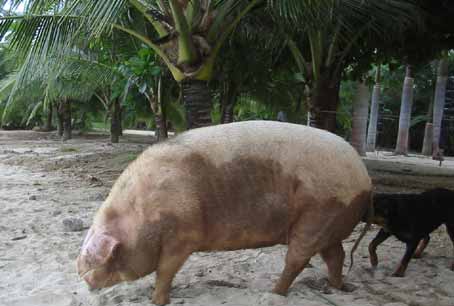
The fatest pig I have ever
seen, 400kg.
Un gros cochon, 400kg de saucisses.
The bikers from Tamarindo,
the Tamarindians.
Les motards de Tamarindo, les tamarindiens.
Will you just leave me alone!!!
Laissez moi tranquille à la fin!!!
Mad Max Simon. (photo
by yours truly)
Simon sur les routes de Panama.
The port in the Old City
of Panama.
Le port dans la vieille ville de Panama.
The old city of Panama.
La vieille ville de Panama.
Modern Panama City.
La ville moderne de Panama.
 |
 |
 |
 |
 |
 |
 |
 |
 |
 |
 |
 |
 |
|
JOURNAL 29.
03/12/03 . Costa Rica, Panama.
Total mileage so far 55,050km .
(Pour la version française
du journal, allez au bas de la page ou cliquez
içi.
Pour revenir à la version française du site, cliquez
sur Français)
How
can you help make Ride4Kids a worthwhile project? To find out,
click here.
|
|


